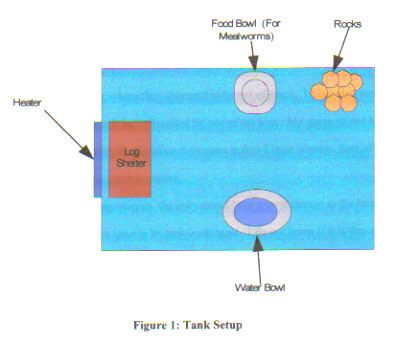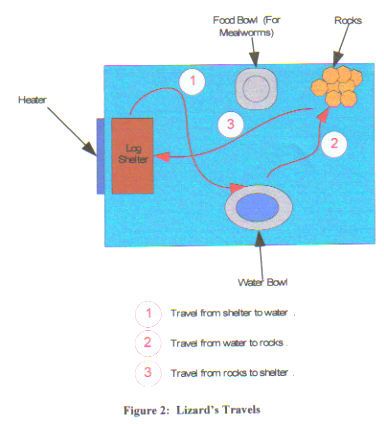
Fall 2007
English 302N02
Dr. Ellen Moody
There are very few occurrences in my house that do not get reported or witnessed by me. When the kids are loud, I hear it. When they fight, cheat each other, dont behave, etc, I most certainly hear about it. When things go well, they proudly interrupt me to let me know their good news. I even hear about the dogs day from my wife, or the kids, as it may be. The one creature I never get any news about is Lizzie, my daughters pet Leopard Gecko. This animals presence is almost non existent in our household. It is quiet, non-intrusive, devoid of feelings, and forgettable. With that in mind, I set out to observe this creature. My aim was to find out its habits and routines and to find out whether or not Lizzie is more active than what it appears to be.
Ill begin by informing you of the information I had before I set out to observe the gecko. From conversations with the pet store employees and a book that came in with the starter kit (fish tank, sand, water bowl, etc) I learned that the Leopard Gecko was a desert dwelling lizard that is most active nocturnally. This particular species of gecko is calm when being handled and rarely bites or tries to escape making it ideal for children to keep as pets. I also knew that the gecko, by virtue of being a reptile, is cold-blooded (body temperature depends on environmental conditions) and has a slow metabolism. Again, ideal for children who might forget to feed it every now and then. The rest of what I have to say here I personally witnessed during the times I have spent in my kids bedroom (where Lizzie is kept) or the three week period I specifically set out to observe the animal.
If I were to describe Lizzies life in one word it would be relaxed. For the most part, the lizard spends its days idly under the U shaped log hiding from the rest of the world. It appears as if it never really moves. Day after day the gecko seems to be in the same place. When purposely observed, the only movement seen is the ever so slight twist of the head that proves that it sees you as well as you see it. Figure 1 shows the way the tank is set up for the lizard.

Considering the idle lifestyle that Lizzie lives, Ill now describe when I have seen the lizard most active. There was a time when Lizzie had not been fed for about two weeks. Its diet mainly consists of mealworms and crickets bought at the pet store. My wife stopped by the pet store earlier in the day and bought a dozen live crickets. When the bag was emptied in the geckos tank, it quickly scurried to the closest one, snatched it up with its jaws and swallowed it in the blink of an eye. This created a panic among the other crickets and they began to hop away in all directions. Of course, the kids who witnessed the appetizer also began to get excited about it. The lizard proceeded to the other crickets, but this time it was slowly; almost slithering. As it got closer to one it would then strike with lighting speed andvoila! One less cricket. By the time that the gecko was done with its show, 8 crickets had disappeared and the others were clinching tightly to the top of the log, where they appeared to be out of reach. I have also seen the gecko move around when it is being handled by one of the kids. My guess would be that the kids running around with the lizard on their arms makes Lizzie queasy. Sort of the feeling we get when riding a roller coaster.
Apart from those experiences, the only time I have seen a change in the behavior of Lizzie has been when the sand in its tank is changed. I do not know if it is the color (they changed in once from tan to red and then again from red to blue sand) or the fact that the sand, by virtue of being new, was devoid of any familiar scents. From my observations, it took the gecko about two days to adjust to the new sand. After the two days, the lizard went back to its idle routines.
In order to observe Lizzie more closely, I formulated a plan to watch the lizard during several different times. I observed it when the kids were in the bedroom. I watched when the kids had been gone for a while and all was peaceful and quiet. I particularly watched at night, once the kids had been asleep for at least an hour. On nights when I was to observe, I used a flashlight with a red lens. This allowed me to keep my night vision and appeared to not disturb the lizard as much as using a normal white light flashlight (I tried those at first). As I suspected, I discovered several things about Lizzie I did not know.
During the day, Lizzie stays indoors under its log. This happened regardless as to who was in the room. When the kids were in the room, being kids (noisy) or watching television or playing, the lizard kept to itself safely at home. Often it does not pay attention to the kids at all, or so I guess because sometimes it is facing opposite of the kids. When you peek in, all you see is its tail. The gecko does not feed or drink during daytime hours. I never saw it once doing it. Not even on random moments when I would quietly enter the room to peek at it. I did this during all hours of the day (on weekends) to see if the lizard would come out when the kids were outside playing. Not once. The gecko was always inside minding its business.
Nighttime brings out the party animal in Lizzie. At about 10 PM or so, I found that the lizard quietly steps out of its concealment and travels about. This is when it drinks water, I suppose. I found it several times at the water dish (although I never saw it drink). This is also when it eats. I carefully counted the number of crickets day after day. It ate one cricket almost daily, occasionally skipping a day. Even more impressive, I found that there was a regular pattern that Lizzie walks within the tank. I did this by taking a poker card and smoothing the sand every evening for about two weeks. The gecko leaves its shelter (located on the left side of the fish tank) from the end closest to he wall (back of the tank). From there, it walks to the water dish (located at the front middle-right side) where it spends a bit of time, maybe half an hour. From there, Lizzie rests on the rocks at the rear right of the tank. This is probably because the rocks are located directly under the heating lamp, which allows them to retain more heat than the sand. Once the gecko was done heating up, it traveled to the shelter, where the crickets climb for safety. I guess from there, it catches a cricket. I did not witness the actual catch. I just counted the missing cricket the next day. Most of the time, I left Lizzie at the shelter before finishing observations for the day. Twice, I saw it begin its climb to the crickets, but this was slow and each time, it felt as though I was distracting it. Finally, Lizzies day ends by traveling back to safety of the shelter. This was an area where the lizard displayed a bit of variety in its travel. Sometimes it entered the log from the front, sometimes from the back. My guess is that it depended on the lizards location when it was done with its hunting. I discovered no clear pattern. By this time it is usually 1 to 2 A.M. since I always checked the gecko anytime I was up late and the 4 or 5 times I checked it at 3 A.M. it was already back to its shelter. Figure 2 shows the lizards travels.

There has been one dramatic change in the ritual that Lizzie performs daily. On a chilly morning, I noticed the bedroom was quite cool. The gecko had not done anything that evening, since the sand was undisturbed. I realized that the temperature was much too cool for the cold blooded lizard to be very active. At this time, I turned on the tank heater on. This heater had been off all summer and is used to keep an area of the tank warm enough for the comfort of the gecko. During winter months, we keep it on to supplement the heat from the light. This heater has a pad that is glued onto the shelter side of the tank. For the lizard, it is most accessible by climbing its shelter and leaning against the wall of the tank. That is exactly what Lizzie does; it now spends several hours every night (usually after 36 A.M.) keeping warm there. During the day, it goes back to the shelter and rests against the log wall closest to the heater. The poor crickets have been displaced from the top of the shelter and now simply keep themselves at the corner opposite of the heater.
Overall, I found my discoveries amazing. I did not know that all this activity took place in that tank. I would have guessed that the lizard hunted by taking advantage of the silly cricket that made its way closest to the shelter entrance. Instead the lizard sought out the crickets. I would also have guessed that the lizard did not go out every day; maybe only on days it was hungry. I was wrong on both accounts.
If I were to study an animal like this again, I would probably approach it a bit differently. For instance, I think I would set up a camera to watch the lizard 24x7. This would give me exact times events took place and I could witness the events at a more leisurely time (I lost sleep on several occasions). I would also not miss events and have to infer as to exactly what happened. I consider my observations successful, but I would have liked more concrete evidence to back up my theories.